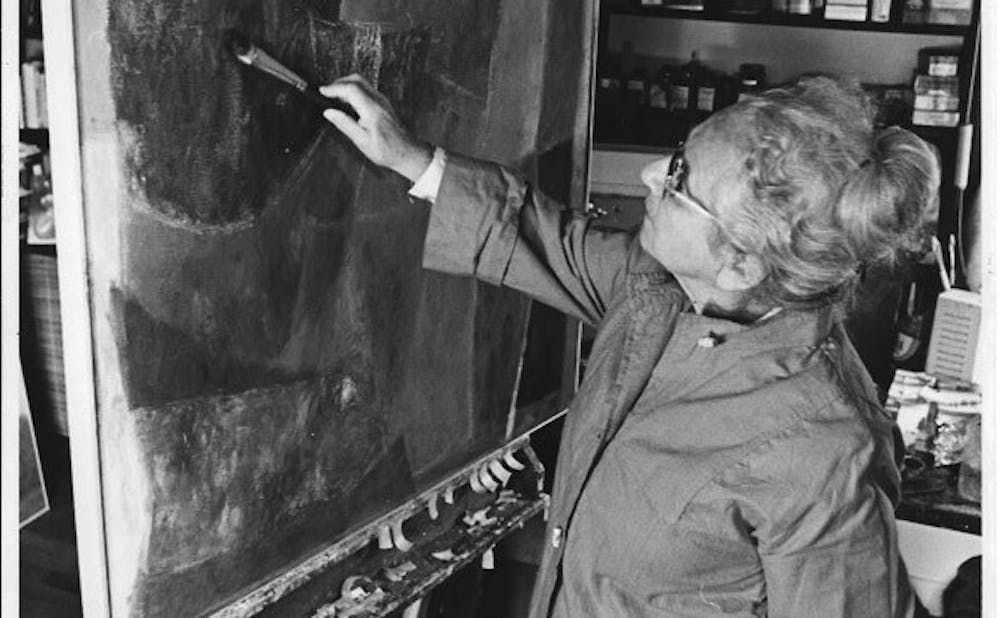The city of Durham has undergone substantial periods of transition and transformation since its antebellum birth. Beginning as a humble station between Hillsborough and Raleigh, Durham has evolved from an industry center for tobacco and textile into a bustling urban center for scholarship and culture. Although many Durhamites were impactful in this evolution of Durham, Silvia Heyden and Edith London were exemplars in making Durham a viable place for artists to create and show work.
Through February 28, the Durham Arts Council will celebrate the art and influence of these two women in an exhibition titled, “Silvia Heyden and Edith London: Together Again.” The exhibit features 30 tapestries from Heyden, a weaver, and 30 paintings from London, a painter and collage artist. The two were close friends and confidants, drawn together by the blossoming arts community of Durham.
“The Durham arts community was really propelled forward by Duke University pulling in intellectuals following the Second World War as well as the Cold War,” Margaret DeMott, Director of Artist Services for the Durham Arts Council, said. “There is this great moment in North Carolina history where all of these different sorts of people began concentrating in one area and this became the Triangle at its inception. Silvia and Edith were a part of that. This is one of those instances where a place and a moment enabled a relationship.”
Heyden recalled first coming in the 1960s and immediately connecting with the arts community. Through a mutual friend, the art director of a museum in downtown Raleigh, Heyden was introduced to London. London was 20 years her senior, but the two were similar in their love of art and in grappling with the questions of modern aesthetics.
“We had lots of discussions about what is art and how to integrate abstraction in geometric patterns and empathy in organic rhythm in our art,” said Heyden. “Those were her basics, but I had to go a much longer way with tapestry than she had to go with painting; I had more ground to make up.”
“Durham was a good place for Silvia and Edith, and they were good to Durham as renowned artists promoting this city,” Sarah Schroth, Director of the Nasher Museum of Art, said. “They were both coming out of this modern moment—Edith from the French side and Silvia from the German side—and they found likeminded colleagues at Duke and in Durham who were really appreciative of their aesthetic.”
Both studied in modern aesthetics, particularly the Bauhaus tradition, and were acclaimed artists in Europe before moving to Durham on account of their husbands’ appointments at Duke University. The Bauhaus tradition concerns the intersection of crafts and high arts. For London, this influence expanded her interests to include collage in addition to painting, but for Heyden the Bauhaus tradition inspired her to elevate weaving from a craft to high art form. She was inspired after seeing old tapestries in a museum in Europe. From the 15th century onward, tapestries were translated from paintings as a more durable medium, but Heyden wanted to change this.
“Modern tapestry is defined as someone who creates their own designs and weaves it themselves,” said Heyden. “I start with no designs in order to avoid translating from another medium. I want to discover how to make a tapestry that comes from itself, from what is possible with the loom. For me, the art is always in the loom.”
Although London passed away in 1997 at the age of 93, Heyden, now 86, still resides on the banks of the Eno River and continues to weave tapestries to this day. The pursuit of discovering the full potential of tapestry is a lifelong pursuit.
“What links Silvia and Edith is their unending pursuit, common aesthetic vocabulary and similar education,” said DeMott. “Silvia never sought to create a tapestry of Edith’s paintings nor did Edith seek to paint Silvia’s tapestries, but their long conversations somehow still end up in their work. When you put it on the wall together, the work talks to each other in the same way that Edith and Silvia did. I hope it stops people and reminds them how powerful visual art can be—it can take someone out of of themselves and allow them to share in a bigger vision.”
Heyden is similarly enthused by the opportunity to have her tapestries shown alongside her late friend’s paintings. This is the first exhibit in which both artists' works are shown with each other, though London was the subject of a show at the Durham Art Guild in 1992.
“Now, in my later years, I can do that stretch that Edith had done before me. I can now put a worthy tapestry beside her painting and that is wonderful for me,” said Heyden. “I’m glad we finally have an exhibit where paintings and tapestries are hanging next to each other, both as art.”
The “Silvia Heyden and Edith London: Together Again” exhibit is currently viewable through February 28 in the SunTrust Gallery at the Durham Arts Council. Silvia Heyden will offer a fiber workshop, “From Fiber to Color,” on February 8, 10:30 a.m. Fee is $15. More details can be found here.
Get The Chronicle straight to your inbox
Signup for our weekly newsletter. Cancel at any time.

